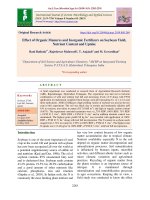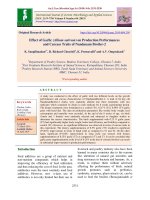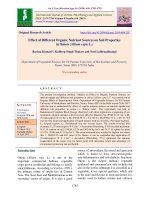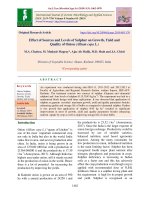Effect of inorganic fertilizers and bio fertilizers on yield and economics of onion (Allium cepa L.) production
Bạn đang xem bản rút gọn của tài liệu. Xem và tải ngay bản đầy đủ của tài liệu tại đây (218.68 KB, 6 trang )
Int.J.Curr.Microbiol.App.Sci (2020) 9(3): 603-608
International Journal of Current Microbiology and Applied Sciences
ISSN: 2319-7706 Volume 9 Number 3 (2020)
Journal homepage:
Original Research Article
/>
Effect of Inorganic Fertilizers and Bio Fertilizers on Yield and Economics
of Onion (Allium cepa L.) Production
Aditya Ranjan1*, Kamal Kant2, Manish Kumar3, NehaKumariSingh4,
SumanKumari5 and Ritu Kumari6
Department of Horticulture (Vegetable and Floriculture), BAC, Bihar Agricultural University,
Sabour, Bhagalpur-813210, India
*Corresponding author
ABSTRACT
Keywords
Inorganic fertilizers,
Bio fertilizers,
Yield and
Economics, Onion
Article Info
Accepted:
05 February 2020
Available Online:
10 March 2020
The experiment was carried out in the Department of Horticulture
(Vegetable and Floriculture), Bihar Agricultural College, Sabour to study
the role of bio fertilizers and chemical fertilizers on onion production. The
experiment was laid out in a factorial randomized block design, replicated
thrice with onion variety Agrifound Light Red. The experiment was framed
with bio fertilizers viz., M0- 0, M1- Azotobacter, M2-Azospirillum, M3PSB, M4-VAM and four levels of chemical fertilizers, (F1-N80 P40 K60, F2N100P60K80, F3-N120P80K100, F4-N140P100K120 having 20 treatment
combinations. The results of the experiment showed that the fertility level
F3-N120P80K100 with inoculation of M2- Azospirillum i.e., F3M2 the
maximum average bulb weight (77.53 g), diameter of bulb (6.17 cm), bulb
length (5.97 cm), bulb yield (438.56 q/ha) was recorded F3M2 treatment
combination, and treatment combination F1MO shows lowest value.
However, inoculation of Azospirillum with soil application at the fertility
level of F3-N120P80K100 was the most effective combination for higher net
return and B: C ratio (4.70).
source of minerals like phosphorus, calcium
and carbohydrate. It also contains protein,
vitamin C. and it has good medicinal values,
it act against carcinogenic factor. Low
productivity of onion may be attributed due to
poor management efficiency rather than that
in the uncontrollable climatic factors. Thus, it
Introduction
Onion (Allium cepa L.) is one of the
important commercial vegetable crops grown
in India. It belongs to family Amaryllidaceae,
grown across over the country. India is
2ndlargest producer next to china. It is rich
603
Int.J.Curr.Microbiol.App.Sci (2020) 9(3): 603-608
makes it imperative to make a concerted
effort to bridge the gap between potential
yield and actual yield harvested by the
farmers to make onion cultivation more
remunerative through better management
strategic of inputs like nutrient management
practices and microbial inoculants for better
exploitation of yield potentialities. Escalating
cost of chemical fertilizers are hampering our
way to produce more per unit area. Moreover,
their excessive use has also resulted in serious
damage to our soil and soil resources and to
human health too. Biofertilizer are carrier
based preparations containing beneficial
microorganism in viable state for soil or seed
application. In recent years they have
emerged as a promising component of
integrated nutrient supply system. They are
likely to assume greater significance as a
complements or supplements to the chemical
fertilizers because of high nutrient turnover,
exorbitant cost of fertilizers, soil and
environmental protection. Biofertilizer are
less expensive, ecofriendly viable and quality
of produce, providing plant hormones and
help in sustainable crop production through
maintenance
of
soil
productivity
(Vijayakumar et al., 2000; Ramakrishnan and
Thamizhiniyan, 2004). The use of chemical
fertilizers in combination with bio fertilizers
offers a great opportunity to increase the crop
production at less cost (Gunjan et al., 2005).
Therefore, the experiment was conducted for
sustainable production of onion with combine
use of bio fertilizers and chemical fertilizers.
size was 2.5 m×1.5 m. The treatment
comprised four bio fertilizers (Mo-No
biofertilizer,
M1-Azotobacter,
M2Azospirillum, M3-PSB, M4-VAM) and four
levels of chemical fertilizers (F1-N80 P40 K60,
F2-N100P60K80,
F3-N120P80K100,
F4N140P100K120). Bio fertilizers were used as soil
application.
Treatment
wise
different
microbial inoculants were applied at the rate
of 5kg/ha and dried F.Y.M in the ratio of 1:20
were mixed thoroughly and mixture was
broadcasted and incorporated in the sub-plots.
After application of the microbial inoculants
the seedlings allocated with respective
microbial inoculants were transplanted at the
spacing of 15 x 10 cm. Full dose of
phosphorus (P2O5) as diammonium phosphate
and potash (K2O) as murate of potash with
1/3rd dose of nitrogen as urea were applied
before transplanting of seedlings as basal
dressing commensurating with treatments
specifications. As per treatment the remaining
dose of N was top dressed in two equal split
i.e., one third at 25 days of transplanting and
the rest at 50 days after transplanting.
Necessary irrigations were given. Gap filling,
intercultural operation and plant protection
measures were given for the better
establishment of crop.
The observations of growth parameter plant
height, number of leaves per plant, diameter
of leaves, and yield attributing characters like
bulb length, bulb diameter, bulb weight and
bulb yield. The statistical analysis of the data
noted in all observations was carried out by
the method of “Analysis of variance as
suggested by Fisher and Yates (1963).
Comparison of the treatments was made with
the help of critical differences (C.D.). The
economics studies of the crop was done by
computing the cost of cultivation and net
profit in rupees per hectare on the basis of the
prevailing rate of inputs and output obtained
from the local market. Gross return was
calculated by multiplying yield (q/ha) with
Materials and Methods
The investigation was carried out at
Vegetable research farm, BAU, Sabour in the
Rabi season 2018. The design of experiment
was factorial randomized block design,
replicated thrice and variety was “Agrifound
Light red”. 45 days old seedlings of uniform
growth were transplanted in evening hour at a
spacing of 15×10 cm in flat beds. The plot
604
Int.J.Curr.Microbiol.App.Sci (2020) 9(3): 603-608
average selling rate of onion bulbs. The net
return (Rs/ha) was computed by subtracting
the cost of cultivation from the gross return
obtained from the sale of the harvested bulb.
The benefit cost ratio i.e. the net return per
rupee investment was obtained by dividing
net profit with total cost of cultivation.
plants resulting in better uptake of N by
plants. VAM or PSB would have caused more
mobilization and solubilization of insoluble P
in the soil and improve the availability of
phosphorus to plants. Better crop due to all
these factors which might have helped in
increasing photosynthetic rate and more
physiological and biochemical activities
which in turn, perhaps increased the
movement of photosynthates from source to
sink. Thus, finally resulted in increasing the
yield and yield components. These results are
in accordance with the findings of
Muthuramalingam et al., (2002), Sule et al.,
(2002), Rather et al., (2003), Yadav et al.,
(2005) and Jha et al., (2006).
Results and Discussion
The results revealed that the application of
microbial inoculant M2 (Azospirillum)
produced maximum plant height (48.57cm),
number of leaves per plant (11.54), leaf length
(43.66 cm), diameter of leaves (1.87 cm) This
treatment was most outstanding being
significantly superior to rest of the
biofertilizers used.
Growth and yield attributing characters were
influenced significantly due to different
fertility level. The maximum plant height
(44.90 cm), number of leaves per plant
(10.39), leaf length (39.86 cm), bulb length
(5.31 cm), bulb diameter (5.46cm), bulb
weight (70.37g), bulb yield (392.94 q/ha), and
were obtained at the fertility level F3N120P80K100, This level was most outstanding
being significantly superior to rest of the
fertility Significant increase in bulb yield due
to different fertility levels has been reported
by Girigowda et al., (2005), Kumar et al.,
(2006) and Dilruba et al., (2006).
This may be due to change in the metabolic
activities of the plant and the uptake of water
and nutrients. In addition to these, microbial
inoculants have ability to produce some
growth promoting substances which might
have led to enhanced cell division and cell
elongation, resulting maximum plant length
and highest number of leaves per plant, leaf
length, collar thickness and fresh weight of
leaves/ plant. The results in respect of these
characters are in complete agreement with the
findings of Mahmoud and El-Hefny (1999),
Rather et al., (2003) and Jha et al., (2006). It
is evident from the data this treatment was
also found effective for producing maximum
bulb length (5.59 cm), bulb diameter
(6.11cm), bulb weight (77.14 g), bulb yield
(435.72 q/ha) followed by the application of
M1 i.e., Azotobacter. The yield improvement
might be due to vigorous habit in terms of
plant height, leaf length, number of leaves and
plants developed under Azospirillum or
Azotobacter.
The interaction effect between different levels
of inorganic fertilizers and bio fertilizers were
found to be quite superior to their sole
application.
Among
the
treatment
combinations F3M2 i.e., application of higher
dosages of inorganic fertilizers i.e., F3
(N120P80K100) along with inoculation of
biofertilizer M2 (Azospirillum) exhibited
significantly highest values of plant height
(48.57 cm),number of leaves per plant(11.54),
leaf
length
(43.66cm),
bulb
length(5.97cm),bulb diameter(6.17 cm),bulb
weight (77.53 g), bulb yield (438.56q/ha).
Azospirillum might have fixed higher amount
of nitrogen in soil and made available to the
605
Int.J.Curr.Microbiol.App.Sci (2020) 9(3): 603-608
Table.1 Effect of levels of biofertilizer and chemical fertilizer on growth and yield attributes for
sustainable onion production
Treatments
Plant
height
(cm.)
M0-No biofertilizer
M1 Azotobacter
M2 Azospirillum
M3 PSB
M4 VAM
CD at 5%
31.74
46.94
47.13
44.96
39.94
1.99
F1-N80 P40 K60
F2-N100P60K80
F3-N120P80K100
F4-N140P100K120
CD at 5%
40.48
44.48
44.90
42.70
1.78
No.of
Leaf
Bulb
leaves
length length
/Plant
(cm.)
(cm)
Level of Bio fertilizers
7.46
27.89
3.77
10.85
41.35
5.32
11.04
41.64
5.59
10.45
40.64
5.41
9.38
35.48
4.80
0.50
1.95
0.24
Level of chemical fertilizer
9.04
34.46
4.36
10.23
39.24
5.19
10.39
39.86
5.31
9.69
36.05
5.07
0.44
1.74
0.22
Bulb
diameter
(cm)
Bulb
weight
(g)
Bulb
yield
q/ha
4.20
5.83
6.11
5.47
4.82
0.24
49.31
75.46
77.14
72.24
62.80
3.71
278.43
420.00
435.72
393.83
343.70
20.06
4.96
5.38
5.46
5.33
0.22
63.02
69.63
70.37
66.54
3.32
350.69
384.77
392.94
368.94
17.94
Table.2 Combined effect of bio fertilizers and chemical fertilizer on growth and yield attributes
for onion production
Interaction
F1M0
F1M1
F1M2
F1M3
F1M4
F2M0
F2M1
F2M2
F2M3
F2M4
F3M0
F3M1
F3M2
F3M3
F3M4
F4M0
F4M1
F4M2
F4M3
F4M4
Plant
height
(cm.)
24.50
46.99
49.51
45.22
36.20
34.56
49.07
49.53
46.40
42.85
35.30
49.49
49.57
46.55
43.60
32.60
48.65
49.53
45.60
37.12
No. of
leaves
/Plant
5.86
11.11
11.35
10.31
8.66
7.99
11.21
11.52
10.52
9.99
8.33
11.35
11.56
10.56
10.24
7.70
11.20
11.45
10.51
8.71
Leaf
length
(cm.)
21.20
42.53
43.25
39.78
31.89
30.57
42.78
43.43
41.20
38.23
31.12
43.15
43.66
42.14
39.25
28.66
42.74
43.42
40.62
32.53
606
Bulb
length
(cm)
2.88
5.51
5.67
5.31
4.41
4.11
5.57
5.92
5.43
4.92
4.20
5.63
5.97
5.48
5.25
3.88
5.57
5.83
5.42
4.63
Bulb
diameter
(cm)
3.25
5.66
6.03
5.11
4.70
4.51
5.82
6.11
5.61
4.87
4.66
5.98
6.17
5.63
4.87
4.37
5.82
6.11
5.52
4.82
Bulb
weight
(g)
37.64
74.21
76.66
70.46
56.13
54.32
75.91
77.51
73.21
67.21
55.01
76.25
77.53
73.43
69.65
50.26
75.47
76.87
71.87
58.21
Bulb yield
(q/ha)
211.45
409.13
433.22
388.21
311.46
306.21
423.66
435.99
396.75
361.24
311.26
430.22
438.56
401.12
383.54
284.78
416.99
435.11
389.25
318.56
Int.J.Curr.Microbiol.App.Sci (2020) 9(3): 603-608
Table.3 Effect of levels of biofertilizer and chemical fertilizer on economics for sustainable
onion production
Treatment
F1M0
F1M1
F1M2
F1M3
F1M4
F2M0
F2M1
F2M2
F2M3
F2M4
F3M0
F3M1
F3M2
F3M3
F3M4
F4M0
F4M1
F4M2
F4M3
F4M4
Bulb yield
(q/ha)
271.45
409.13
403.22
388.21
361.46
326.21
413.66
420.99
396.75
361.24
311.26
425.22
438.56
401.12
395.54
334.78
416.99
415.11
389.25
308.56
Rate in
(q/ha)
1000
1000
1000
1000
1000
1000
1000
1000
1000
1000
1000
1000
1000
1000
1000
1000
1000
1000
1000
1000
Gross income
(Rs)
271450
409130
403220
388210
361460
326210
413660
420990
396750
361240
311260
425220
438560
401120
395540
334780
416990
415110
389250
308560
This may be due to the profuse vegetative
growth induced by higher dose of chemical
fertilizers and application of microbial
inoculant M2 (Azospirillum). This ultimately
may increase the photosynthetic assimilation.
All these physiological activities brought
about increase in bulb size and bulb weight as
the weight of individual bulb increased it
reflected positively on the total bulb yield.
The results are closely in consonance with the
finding of Singh and Singh (2002), El-Shaikh
(2005), Jayathilake et al., (2002), Singh and
Pandey (2006) and Yogita and Ram (2012)
Total cost of
cultivation (Rs)
71931
75931
75931
75931
75931
77251
81251
81251
81251
81251
72952
76952
76952
76952
76952
73491
77491
77491
77491
77491
Net income
(Rs)
199519
333199
327289
312279
285529
248959
332409
339739
315499
279989
238308
348268
361608
324168
318588
261289
339499
337619
311759
231069
B:C
Ratio
2.77
4.39
4.31
4.11
3.76
3.22
4.09
4.18
3.88
3.45
3.27
4.53
4.70
4.21
4.14
3.56
4.38
4.36
4.02
2.98
inorganic fertilizers was found to be highly
significant, meaning thereby that different
fertility levels influenced the bio fertilizers
behavior and vice-versa. The highest net
profit of Rs.361608.00/ha with the maximum
benefit-cost ratio of 4.70 were obtained with
the application of microbial inoculant M2
(Azospirillum) at the fertility level of F3
(N120P80K100) i.e., F3M2. The lowest fertility
level of F1 in the absence of bio fertilizers i.e.,
F1MO produced the minimum net profit (Rs.
199519. 00/ha) with B: C ratio (2:77).
Application of higher dosages of inorganic
fertilizers i.e. F3 (N120P80K100) along with
inoculation of bio fertilizer M2 (Azospirillum)
influenced the growth as well as yield
Economics
The interaction between bio fertilizers and
607
Int.J.Curr.Microbiol.App.Sci (2020) 9(3): 603-608
contributing characters and bulb yield
significantly in comparison to the remaining
treatment combinations. Hence, the use and
management of natural resources in
sustainable
agriculture,
the
microbial
fertilizers hold vast potential for the future.
185.
Jha, A.K., Pal, Netra, Saxena, A.K., Singh,
Dhyan and Jha, G. K. 2006.
Coinoculation effect of VAM and PGR
on growth and yield of onion. Ind. J.
Hort. 63 (1): 44-47.
Kumar Susheel, Tiwari Sushant, C. P. and
Singh, Vijay 2006. Bulb yield and quality
of onion (Allium cepa L.) as affected by
application rates of nitrogen and
potassium fertilizer. Agril. Sci. Digest. 26
(1): 11-14.
Singh, A., Singh, S. P. and Singh, B. O. 2002.
Effect of VAM and inorganic fertilizers
on growth and yield of onion (Allium
cepa L.). Vegetable Science. 29 (1): 4042.
Sule, S.R., Rahane, R. K. and Shinde, V. A.
2002. Impact of biofertilizers on
productivity
of
field
crops.
J.
Maharashtra Agril. Univ. 27 (2): 180181.
Vijayakumar, B.S., P. V.Bhiravamurthy and
Anand, M. C. 2000. VAM fungi
association in Lycoperiscon esculentum
L. grown in semi-arid tropical soils of
Puttaparthy, A.P.J. Ecobiol., 12 (1): 7374.
YadavDashrath, Prasad, V. M. and Gujar, K.
D. 2005. Effect of different biofertilizers
in association with phosphorus on growth
and yield of onion (Allium cepa L.), a
white onion var. JNDWO. New
Agriculturist. 16 (1/2): 87-89.
Yogita and Ram, R. B. 2012. Interaction
effect of chemical and bio-fertilizers on
growth and yield of onion (Allium cepa
L.). Hort Flora Research Spectrum, 1(3):
239-243.
References
Dilruba, S., Alam, M.M., Rahman M.A., and
Hasan M. F. 2006. Influence of nitrogen
and potassium on yield contributing bulb
traits of onion. International J. Agril. Res.
1 (1): 85-90.
El- Shaikh and K.A.A., 2005. Growth and
yield of onion as affected by
biofertilization, application of nitrogen
and phosphorus fertilizers under South
Valley Conditions. Assiut J. Agril. Sci. 36
(1): 37-50.
Fisher, R.A., and Yates, F. 1963. Statistical
tables for Biological, Agricultural and
Medical Research, Long Man Group
Limited, London. Sixth Edition.
Girigowda, J.R., Narasegowda, N. C. and
Krishna, H. C. 2005. Effect of fertilizer
levels on uptake of primary nutrients and
bulb yield of on hybrids. Mysore J. Agril.
Sci. 39 (4): 557-560.
GunjanAswani, Paliwal, R. and Saralia, D. K.
2005. Effect of nitrogen and biofertilizers
on yield and quality of rabi onion (Allium
cepa L.) cv. Puna Red. Agril. Sci. Digest,
25 (2): 124-126.
Jayathilake, P.K.S., Reddy, I. P., Srihari, D.,
Neeraja, G. and Reddy, R. 2002. Effect of
nutrient management on growth, yield
and yield attributes of rabionion (Allium
cepa L.). Vegetable Science. 29(2): 184How to cite this article:
Aditya Ranjan, Kamal Kant, Manish Kumar, Neha Kumari Singh, Suman Kumari and Ritu
Kumari. 2020. Effect of Inorganic Fertilizers and Bio Fertilizers on Yield and Economics of
Onion (Allium cepa L.) Production. Int.J.Curr.Microbiol.App.Sci. 9(03): 603-608.
doi: />
608









